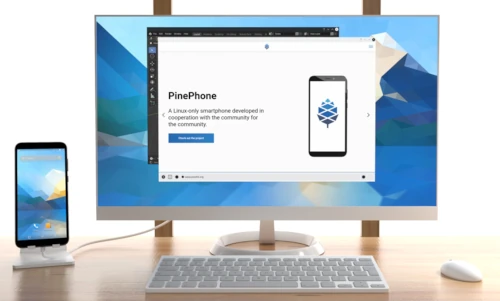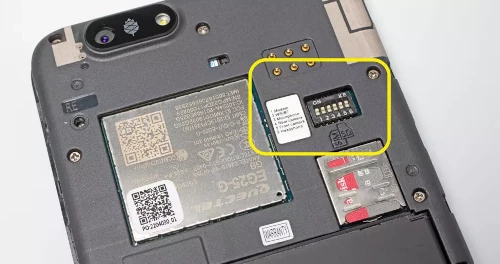PinePhone Pro: The Linux Smartphone That Makes Apple and Google Look Ridiculous

At first glance, nothing sets my PinePhone Pro apart from any other smartphone. So far, nothing too exciting. Especially in the era of bezel-less OLED screens and polished glass bodies. But as soon as you press the power button, you realize you’re holding something radically different from Android or iOS.
No Apple logo appears, nor does a blinking green robot. Instead, you get a clean startup screen followed by an interface that immediately reminds you of a Linux computer. This means you can finally say goodbye to those annoying pre-installed apps. The first time I saw this, I thought, “Finally, a phone that doesn’t treat me like an idiot!” The PinePhone Pro is living proof that it’s still possible to design a device that respects its users instead of treating them like products.
The PinePhone Pro: The Linux Smartphone That Makes Apple and Google Look Ridiculous
When you first power up a PinePhone Pro, you get this amazing sense of freedom from what we’ve been brainwashed to accept. It’s so refreshing to skip the setup that demands your Google or Apple account right off the bat, not to mention those endless terms and conditions we all just click through without reading.
Instead of those annoying setup steps designed to spy on you later, you get a system that boots up like a Linux PC and lets you do whatever you want. Because yes, the PinePhone Pro is first and foremost a pocket computer. A real one! With a terminal, a package manager, and the ability to install just about any mobile Linux distribution.
Personally, I started with Manjaro running KDE Plasma Mobile – a pretty well-designed touch interface. Then I switched to postmarketOS, which is lighter and more raw. Perfect for those who like to tinker under the hood. Finally, just for kicks, I tried Ubuntu Touch, which offers a more mainstream experience while staying 100% open source.

Of course, you’ve got to enjoy tinkering. You’ve got to be okay with things not always working perfectly out of the box. Sometimes you might need to open a terminal to fix something or compile a kernel to add features… But that’s exactly what makes the PinePhone Pro so special.
And then there’s repairability – a topic near and dear to my heart. The PinePhone Pro’s hardware follows a similar philosophy to Fairphone: everything is designed to be easily taken apart, replaced, and upgraded. The battery? Just remove two screws. Broken screen? A screwdriver and some patience is all you need. For everything else, all connectors are standardized, parts are readily available, and there’s plenty of online documentation. In a world where even €1,000 phones are designed to become obsolete in two years, this is truly revolutionary.
Six Physical Switches to Take Back Control of Your Privacy
There’s one feature of the PinePhone Pro that really stands out: its six physical switches. These discreet little buttons on the back, under a removable cover, let you instantly cut power to the microphone, front camera, rear camera, headphone jack, Wi-Fi, and mobile network. No software or fake “airplane mode” that some shady update could override. With this system, when you turn off your mic or camera, you can be 100% certain they’re off and completely inaccessible to anyone on the network. Particularly useful in countries with extreme government surveillance.

And there’s something deeply satisfying about hearing that click when you disable a component. Probably because it’s real! Not like those “permissions” we blindly grant to completely opaque apps. Here, there’s no need to “trust” some manufacturer or shady operating system. Just absolute control over what your device can and cannot do.
What If We Finally Ditch Apps? (Spoiler: It’s Possible and Liberating)
“But how do I live without my banking app? Without Uber? Without Instagram?” That’s what everyone asks about the PinePhone Pro. But the answer is simple: use the web browser! It’s really not more complicated than that.
Of course, it’s not as smooth as native apps. Granted, some features might be missing. But in 90% of cases, the web versions work perfectly fine. For banking? Most have great mobile sites. Social media? Same deal. Need a ride? Uber’s website works just fine. And for that remaining 10%, there’s always Waydroid or Anbox – two open-source solutions for running Android apps in containers. But honestly, the real goal should be to break free completely. Because once we stop relying on these walled gardens, we take back control from those snooping corporations.
And this is where the PinePhone Pro becomes something much bigger than itself – it forces us to ask a fundamental question: Do we really need all these apps? Or have we just been brainwashed into thinking we can’t live without them?
App developers should really consider going open source instead of constantly whining about Google and Apple. I mean, with their outrageous app store fees and arbitrary rules. But how many actually bother to port their apps to mobile Linux? Hardly any! “They tell us we can’t live without their app stores, but nobody bothers to create real alternatives,” complains a postmarketOS contributor. Yet the PinePhone Pro shows it’s totally doable. So why keep feeding the GAFAM beast when we could be building something better? That’s the real question.
A Phone That Owns Its Limitations Without Apologies
Admittedly, the PinePhone Pro isn’t perfect. Its Rockchip RK3399S processor won’t win any speed races. But with its two Cortex-A72 cores and four Cortex-A53 cores, it handles web browsing, emails, calls, and can even run a small web server or VPN. No, it won’t run the latest 3D games and it’s not as smooth as an iPhone. But who cares? A phone’s main job is to make calls. Everything else is just gravy. And having a full Linux console in your palm? That’s way more than just gravy.
The 13 MP camera gets the job done, but don’t expect miracles. As for battery life, the 3000 mAh battery easily lasts a full day with normal use. True, it’s not breaking any records. But it’s good enough that you won’t stress about it. And if you ever need more juice, you can always carry a spare battery – it takes less than two minutes to swap.
Who Is This Phone For?
Bottom line: the PinePhone Pro isn’t for everyone. It’s for those who are fed up with walled gardens. For those who want to understand how their devices work. And for those who refuse to let shady algorithms control their behavior.
But don’t get me wrong – this doesn’t mean the PinePhone Pro is only for Linux experts. Not at all! To use this kind of device well, you just need to step slightly out of your comfort zone and take a little time to learn how it works. And with all the documentation and helpful forums out there, that’s easier than ever. So this phone is for you if you’re ready to break free from GAFAM’s surveillance. Plus, if you just want to use it for calls and web browsing, you don’t need any technical skills at all.
A Commercial Flop, But a Symbolic Victory
Unfortunately, there was some bad news no one wanted to hear: Pine64 stopped production of the PinePhone Pro because sales weren’t strong enough. Yet despite this commercial failure, the PinePhone Pro remains a symbolic victory. It proved that it’s possible to create an open, repairable, privacy-respecting smartphone. It showed that Apple and Google’s dominance isn’t inevitable. And most importantly, it inspired a whole generation of tinkerers, developers, and dreamers working toward a better future. But you can still find them second-hand or refurbished online. “I bought two,” one user told me. “One to use now, and one for when the first one gives out.”
And alongside that, there are all these crazy projects popping up everywhere. People building DIY phones with Raspberry Pi and PiTalk modules. Communities porting Linux to old smartphones. These represent real alternatives that could chip away at GAFAM’s market share – if enough people support these initiatives. Speaking of which, if you’re interested in this topic, we’re working on a big feature about DIY smartphone alternatives. So stay tuned to NovaFuture – it’s coming soon!
In Conclusion: The PinePhone Pro Is a True Legend
Let’s be real: the PinePhone Pro is also a hacker’s dream phone. It lets you operate discreetly on networks and even crack or jailbreak Android and iOS devices. In short, once you understand its full potential, you realize this smartphone is a true legend. So if you want the Linux smartphone revolution to continue, ditch GAFAM and go fully open source. Because the more of us who do this, the more manufacturers will be motivated to create Linux-friendly mobile devices.
If you found this article interesting, please consider supporting the site by buying us a coffee on Buy Me a Coffee. And if you have any questions or just want to chat about this topic, feel free to use the comment section below. Also, please share this post on your networks. And see you soon for more adventures in the world of free technology 🙂